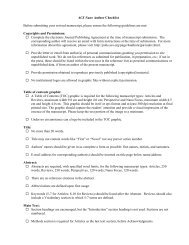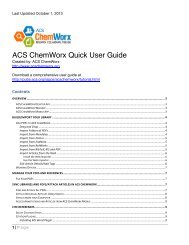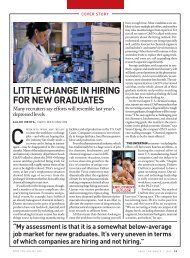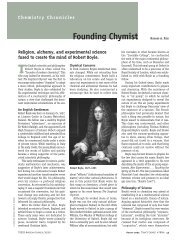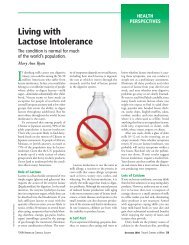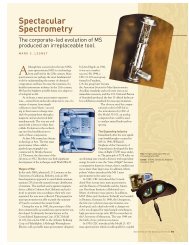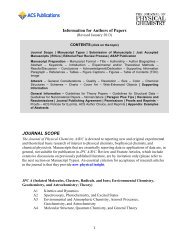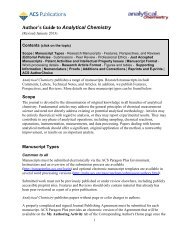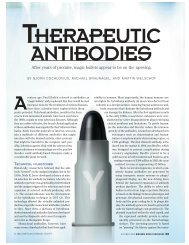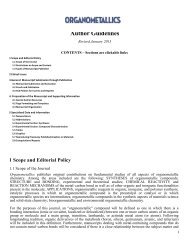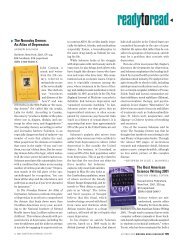Keeping a Balance - American Chemical Society Publications
Keeping a Balance - American Chemical Society Publications
Keeping a Balance - American Chemical Society Publications
Create successful ePaper yourself
Turn your PDF publications into a flip-book with our unique Google optimized e-Paper software.
Technology & Tools<br />
technology. The readouts of our “black<br />
box” instruments have become something<br />
that is taken for granted—assumed<br />
to be accurate and precise. The humble<br />
balance seems so straightforward and obvious,<br />
with its typical “zeroing” function<br />
that seems to solve all problems, and the<br />
profound level of user comfort that the<br />
balances usually afford to the long-time<br />
practitioner. It is easy to forget—especially<br />
with ever-decreasing weights able to be<br />
measured—that calibration is key to<br />
preventing errors (both systemic and<br />
random) that can strongly influence results<br />
and reproducibility, leading not only to<br />
experimental failure but to potential<br />
lawsuits where regulatory issues are<br />
concerned.<br />
The One-Armed Pan<br />
Improvements in balances have been one<br />
of the key foundations of the success of<br />
modern chemistry (1). The classic, twopanned<br />
chemical balance made its appearance<br />
in the 18th century, adapted from<br />
pharmaceutical and coin balances. It had<br />
a single beam suspended on a knife-edge<br />
with a pan on either side. A sample was<br />
weighed by balancing it in one pan against<br />
standard weights in the other. The first<br />
precision balances were made by London<br />
manufacturer Thomas C. Robinson, who<br />
supplied short triangular-beam balances<br />
with a movable pointer to determine the<br />
null point. Many further adaptations<br />
improved the precision and sensitivity of<br />
such balances, such as the introduction<br />
of aluminum by Florenz Sartorious for<br />
construction of the beams. In 1947, the<br />
Swiss firm of Ehrhard Mettler began<br />
commercialization of the single-pan substitution<br />
weighing balance.<br />
In the single-pan substitution balance,<br />
the opposite side of the short beam carries<br />
a continuous load of weights. These weights<br />
are mechanically removed until approximate<br />
balance with the sample in the pan<br />
ILLUSTRATION: TONY FERNANDEZ It is easy to become complacent about<br />
©2003 AMERICAN CHEMICAL SOCIETY<br />
<strong>Keeping</strong> a <strong>Balance</strong><br />
These instruments have come a long “weigh”,<br />
but even with electronics, calibration is key.<br />
is reached. The remaining weight (within<br />
one gram) can be estimated using a dialable<br />
optical scale. This type of balance<br />
remained the standard until the development<br />
of electronic balances.<br />
Enter Electronics<br />
By the 1950s, microbalances that relied<br />
on beams made of quartz rods with a<br />
central quartz fiber were developed (2).<br />
Upon displacement, the fiber was twisted<br />
to restore balance, and this could be<br />
calibrated to give changes in mass. In<br />
the modern electronic balance, the rod is<br />
FIGURE 1: Mechanical vs Electronic <strong>Balance</strong>.<br />
held in position in such a manner that<br />
the pan does not move. Instead, a permanent<br />
magnet generates an electromagnetic<br />
field with current regulated by a position<br />
sensor and measured by an analog–digital<br />
converter. This electromagnetic field<br />
compensates to balance the force pressing<br />
downward onto the pan from the<br />
sample being weighed, holding the beam<br />
in place. When carefully calibrated, the<br />
amount of current needed to keep the pan<br />
balanced can be used to determine the<br />
weight of the sample.<br />
Several important benefits accrue<br />
from using electronic technology for<br />
balances. First and foremost, mechanical<br />
stresses such as those that occur in a<br />
moving balance are all but eliminated<br />
except in the case of user error. Second,<br />
the sensitivity of the measurements is high,<br />
MARK S. LESNEY<br />
and the potential for monitoring the<br />
electronic signals provides an obvious entrée<br />
to computer networking once the analog<br />
signal is digitized.<br />
Coping with Calibration<br />
Calibrating a balance not only is a research<br />
necessity but has also become a regulatory<br />
fiat for laboraties wishing to be in compliance<br />
with the variety of Good Laboratory/Good<br />
Manufacturing Practices<br />
(GLP/GMP), not to mention with ISO/IEC<br />
standards and, in the pharmaceutical arena,<br />
with U.S. Pharmacopeia (USP) standards.<br />
<strong>Balance</strong>s are calibrated either through<br />
the use of standardized masses or by using<br />
built-in calibration masses. The correct<br />
mass or masses used for calibration are<br />
based on the weighing range of the balance<br />
in question. Obviously, a kilogram weight<br />
is useless for calibrating a balance that<br />
works from micrograms to hundreds of<br />
grams; but even more subtly, modern electronic<br />
balances can require certain specific<br />
weights to trigger their programmed scale<br />
calibrations. Mass standards are a critically<br />
important regulatory issue because not<br />
everyone has access to the platinum–iridium<br />
kilogram standard in France (although<br />
lately that might not even be good enough;<br />
see box, “No Weigh!”). External calibration<br />
using ASTM-standard mass weights from<br />
companies like Rice Lake Weighing Systems<br />
and Troemner, often carried out by an independent<br />
contractor (of which there are<br />
many), is considered perhaps the safest<br />
and most rigid means of assuring that a<br />
balance is operating correctly, and it can<br />
NOVEMBER 2003 TODAY’S CHEMIST AT WORK 45
e one of the best ways to demonstrate<br />
regulatory compliance.<br />
But even if the balance itself is carefully<br />
calibrated according to the most<br />
precise weight standards, the operation<br />
of weighing remains fraught with peril—<br />
with a host of critical parameters such as<br />
temperature, air pressure, and vibratory<br />
disturbances that must be gauged. According<br />
to Mettler Toledo, the vast progress in<br />
balance technology that has made balances<br />
so adaptable “is associated with the danger<br />
that too little attention is paid to the influences<br />
of the surroundings.”<br />
A variety of subtle phenomena influence<br />
weighing directly. These include “physical<br />
effects that are measurable for micro,<br />
semimicro, and analytical balances and<br />
cannot be suppressed by them since actual<br />
weight changes are involved or forces<br />
that act on the weighing sample and the<br />
weighing pan”.<br />
Among these parameters are changes<br />
in air pressure, temperature (both ambient<br />
and sample), and surprisingly enough,<br />
gravity. Because gravity is proportional<br />
Selected <strong>Balance</strong> Manufacturers*<br />
A&D Weighing www.andweighing.com<br />
Denver Instruments www.denverinstrument.com<br />
Mettler Toledo www.mt.com<br />
NRD www.nrdstaticcontrol.com<br />
Ohaus www.ohaus.com<br />
Rice Lake Weighing<br />
Systems www.rlws.com<br />
Sartorius www.sartorius.com<br />
Scientech www.scientech-inc.com<br />
Shimadzu Scientific<br />
Instruments www.ssi.shimadzu.com<br />
Troemner www.troemner.com<br />
*For a more complete listing, see www.LabGuideonline.com.<br />
to distance from the center of the earth,<br />
a 200.0000-g weight on the first floor<br />
will register 199.99937 g when measured<br />
on the fourth floor. Mettler Toledo provides<br />
a 20-page brochure, also available online,<br />
that examines many of the problems<br />
associated with correct weighing using electronic<br />
balances (3).<br />
Sensitives and Superheroes<br />
There are continual developments in<br />
modern weighing systems, including better<br />
internal calibration, error parameter warnings<br />
focused on preset values—set by<br />
the user and regulation-based. This is espe-<br />
cially critical in a world that is more and<br />
more dictated by considerations such as<br />
GLP, GMP, and ISO 9000. And, as part of<br />
an ever more integrated laboratory environment,<br />
balances have also entered the<br />
world of networking (see Networking<br />
<strong>Balance</strong>s, Today’s Chemist At Work, September<br />
2003, p 41).<br />
Because researchers rely on balances so<br />
routinely, most major balance instrument<br />
manufacturers such as Sartorius and Mettler<br />
Toledo provide various functional additions<br />
to address some of the potential problems<br />
in the weighing process. For example, builtin<br />
static electricity elimination and configurable<br />
draft-shield systems such as the<br />
Staticmaster ionizer equipment from NRD<br />
are available. Far from the simple tare<br />
systems of old, modern balances are capable<br />
of calibrating automatically for differences<br />
in ambient temperature, humidity,<br />
gravity, or atmospheric pressure. In some<br />
cases, monitored parameters are coupled<br />
to regulatory guidelines. For example, Sartorius<br />
ultramicro and microbalances have<br />
an SQmin function that warns the laboratory<br />
user when the weight on<br />
the balance is below the mini-<br />
mum allowable sample weight<br />
required by the USP (4).<br />
Unique variables of the<br />
sample itself, however, still<br />
require user monitoring. As with<br />
highly hygroscopic or volatile<br />
samples, samples at nonambient<br />
temperatures cannot be<br />
adapted to by internal balance<br />
systems that rely on the behavior<br />
of calibration standards. And<br />
“fluffy” samples can also be a<br />
particular problem, because in<br />
the world of balances, due to<br />
the effect of air displacement,<br />
the proverbial pound of lead<br />
does indeed weigh more than<br />
a pound of feathers at 1 atm.<br />
In the modern world, analytical balances<br />
have often been transformed into dedicated<br />
tools, adapted uniquely for specific<br />
types of analysis. For example, directly<br />
related to the problems of sample volatility,<br />
“loss on drying” results are often a critically<br />
important parameter to monitor in<br />
the food processing, chemical manufacturing,<br />
and pharmaceutical industries. To<br />
determine this parameter, a moistureanalyzing<br />
balance is required. The Ohaus<br />
moisture analyzer, for example, allows accurate<br />
weighing while using a fast-heating<br />
halogen system to raise sample tempera-<br />
No Weigh!<br />
Apparently, the kilogram isn’t what it<br />
used to be. “Le grand K”, the kilogram<br />
standard cast in France in the late 1800s,<br />
the only modern measurement still tied<br />
to a physical entity, has been drifting<br />
in mass every year by a few millionths<br />
of a gram when compared with six copies<br />
made at the same time. Even weighing<br />
the standard is a perilous process, knocking<br />
off irreplaceable, though microscopic,<br />
flecks each time. (This lost weight,<br />
however, may be being made up by the<br />
absorption of atmospheric contaminants.)<br />
So the search continues for an acceptable<br />
physical constant rather than a physical<br />
thing (5).<br />
tures to ~180 °C. A graphical computer<br />
analysis displays “% moisture”, “% solids”,<br />
and “temperature”, as well as a drying<br />
curve in real time. Such computerization<br />
of information output to turn raw data<br />
into usable information is becoming more<br />
common among most manufacturers.<br />
Weighty Issues<br />
From the newest mass comparators to stateof-the-art<br />
moisture analyzers, from ultramicro-balances<br />
to factory-floor thousandsof-kilogram<br />
weighing devices, from<br />
classroom lab bench top-loaders to the most<br />
delicate analytical precision instruments,<br />
the world of weighing continues to become<br />
more sophisticated as manufacturers and<br />
researchers attempt to take both the effort<br />
and the error out of what is arguably the<br />
most important measurement of all.<br />
References<br />
(1) Bud, R., Warner, D. J., Eds. Instruments of<br />
Science; Garland Publishing, Inc.: London, 1998.<br />
(2) Van Huisteden, Z. Basic scale and balance<br />
technology; www.weighing-systems.com/<br />
TechnologyCentre/<strong>Balance</strong>s.html.<br />
(3) The proper way to work with electronic analytical<br />
and microbalances; www.mt.com/mt/resource<br />
detail/brochures.jsp?m=t&key=U1MTg4NjM1NT.<br />
(4) Two new giants in micro-weighing; www.<br />
laboratorytalk.com/news/srt/srt116.html.<br />
(5) Witzke, A. An Effort to Fix the Kilogram. Philadelphia<br />
Inquirer, Dec 22, 2002; www.philly.com/<br />
mld/inquirer/news/nation/4790278.htm.<br />
Mark S. Lesney is a senior associate editor<br />
of Today’s Chemist at Work. Send your comments<br />
or questions about this article to<br />
tcaw@acs.org or to the Editorial Office<br />
address on page 3. ◆<br />
46 TODAY’S CHEMIST AT WORK NOVEMBER 2003 www.tcawonline.org



